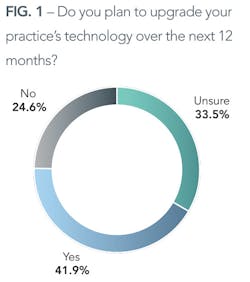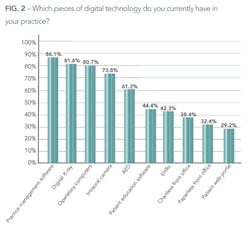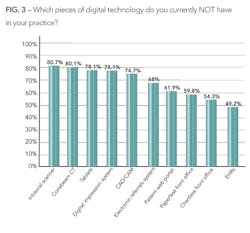By Lerin madole, editorial intern
Dental professionals seem to be reporting current use of the same set of digital systems. At the same time, those looking to "go more digital" in coming months are eyeballing the same set of technologies that are less commonly used as of now. Everyone began their digital integration with the same products industry-wide, and are following a common path for progress.
In last month's issue of Proofs, we discussed digital radiography to see where the industry lies, and where we're headed. We found that new digital options in that realm offer flexibility and improvement in the dental practice. With that onward-and-upward frame of mind, we set out to learn more about digital dental technology. We wanted to know what digital pieces are already being used and what plans are being made to further digitize. We also wanted to see how the industry circulates information and find out what influences plans for in-office upgrade.
We heard from a good number of dentists and a pretty hefty minority of RDHs. Many of these dental professionals have been in practice for over 30 years. They have some good feedback on which new techy pieces have already improved their work and which ones they're looking at most closely for their next upgrade. Operatory computers, digital X-rays, intraoral cameras, practice-management software, and AEDs (automated external defibrillator) are among those digital improvements that the majority of practices have already incorporated. A good number are also using patient education software and EHRs/EDRs (electronic health records/electronic dental records), and have already gone chartless or paperless in their front offices.
Digital systems that are fewer and farther between include electronic referral systems, patient Web portals, CAD/CAM, CBCTs (come beam), digital impression systems, intraoral scanners, and tablets (iPads, etc.) for data input. There is a correlation, though, between these less-used systems and the level of influence they have on plans for future improvement. These are all of popular consideration for the next digital upgrade in dental practices. Almost half of our surveyed dental professionals are already planning to make those changes over the next 12 months; and a whopping 36% of those not yet planning said that they were "unsure" and probably only need more information.
Information often spreads in the dental industry by word of mouth. Colleagues exchange new findings, dental professionals rub elbows at tradeshows, and, of course, sales reps carry out information on the newest technology as well. We found, though, that the most common go-to for technology updates is good old-fashioned magazine articles – like this one! This is especially true when they're so readily available for digital subscription to save time, money, paper, and mailing costs. The idea of going paperless isn't really effecting practice decisions to go "more digital," but we found that many dentists are asking questions about EHR in general. Making a smooth transition from paper to electronic, without interruption to the practice fluidity, is a little daunting.
Lingering questions on the subject of digital dentistry are about security, system details, industry niche technologies, and how to stay up-to-date on industry changes. There are questions about continuing to offer quality patient care while learning new digital systems. That said, we hope we've answered a few questions here with our survey on digital dentistry. Rest assured that we plan to dig deeper as we move onward and upward, that we may continue to keep you in the digital know.









